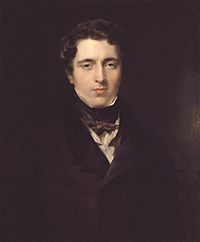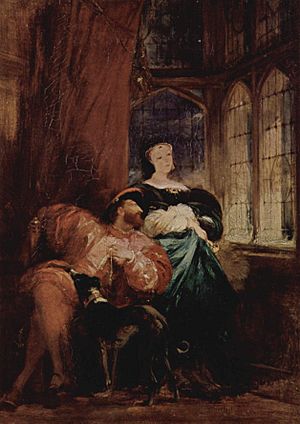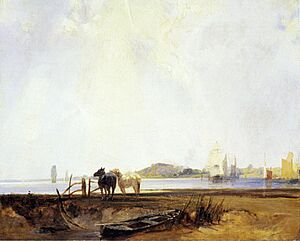Richard Parkes Bonington facts for kids
Quick facts for kids
Richard Parkes Bonington
|
|
|---|---|

Portrait of Richard Parkes Bonington by Margaret Sarah Carpenter
|
|
| Born | 25 October 1802 Arnold, Nottinghamshire, England
|
| Died | 23 September 1828 (aged 25) London, England
|
| Nationality | British/French |
| Education | École des Beaux-Arts, Paris |
| Movement | Orientalist, Romanticism |
Richard Parkes Bonington (born October 25, 1802 – died September 23, 1828) was an English Romantic landscape painter. He moved to France when he was 14, so he's seen as both an English and French artist. He helped share English painting styles in France.
Even though he died young, Bonington became one of the most important British artists of his time. His painting style was inspired by older artists but felt very new. He often painted scenes of the coast with big skies, showing amazing light and air. He also painted small historical pictures in a style called "troubadour."
Contents
Bonington's Artistic Journey

Richard Parkes Bonington was born in Arnold, a town near Nottingham, England. His father, also named Richard, worked as a prison guard, a drawing teacher, and a lace-maker. His mother was a teacher. Bonington learned how to paint with watercolors from his father. He even showed his paintings at the Liverpool Academy when he was just eleven years old.
In 1817, Bonington's family moved to Calais, France. His father started a lace factory there. Bonington began taking lessons from a painter named François Louis Thomas Francia. Francia had recently returned from England and was very inspired by the work of Thomas Girtin. He taught Bonington the English way of using watercolors.
In 1818, the Bonington family moved to Paris to open a lace shop. There, Richard met and became friends with Eugène Delacroix, who was also a famous painter. For a while, Bonington worked at the Louvre museum, copying famous Dutch and Flemish landscape paintings. In 1820, he started attending the École des Beaux-Arts in Paris, which is a famous art school. He studied there with Antoine-Jean, Baron Gros.
Developing His Style
Around this time, Bonington started taking trips to sketch in the areas around Paris. His first paintings were shown at the Paris Salon in 1822. He also began to work with oil paints and lithography, which is a type of printing. He created illustrations for Baron Taylor's Voyages pittoresques dans l'ancienne France and his own series of architectural drawings called Restes et Fragmens.
In 1824, he won a gold medal at the Paris Salon, along with John Constable and Anthony Vandyke Copley Fielding. He spent most of that year painting coastal views in Dunkirk.
In 1825, he met Delacroix again during a visit to London. They sketched together and even shared a studio in Paris for a few months when they returned. Delacroix encouraged Bonington to try historical painting. Bonington also developed a special technique. He mixed watercolor with gouache (a type of opaque watercolor) and gum. This made his paintings look almost like oil paintings.
In 1826, he visited northern Italy and stayed in Venice for a month. He also visited London again in 1827–1828. In late 1828, his tuberculosis became worse. His parents sent him back to London for treatment. Sadly, Bonington died from tuberculosis on September 23, 1828, in London. He was only 25 years old. He was first buried in the graveyard of St James's Chapel Pentonville. Later, in 1837, his remains were moved to Kensal Green Cemetery to be buried with his parents.
Bonington's Legacy

Many artists and critics admired Bonington's work. The famous painter Eugène Delacroix praised Bonington in a letter in 1861. He wrote that when he first met Bonington, they were both very young. Delacroix said that Bonington had an amazing skill with watercolors, which was a new style from England at the time. He felt that Bonington's works had a special "lightness of touch" that made them beautiful to look at, like a diamond.
However, art historian Laurence Binyon felt that Bonington's amazing technical skill might have been too easy for him. He thought Bonington's paintings didn't show the "interest of struggle" that some other artists' works did.
Besides his watercolors, Bonington is also known for his detailed drawings made with graphite pencil, especially his cityscapes.
Influence on Other Artists
Bonington had many artists who followed his style. These included Roqueplan and Isabey in France, and Thomas Shotter Boys, James Holland, William Callow, and John Scarlett Davis in England. Because his work was so popular, many copies and even fake versions of his paintings were made soon after he died.
A statue of Richard Parkes Bonington was put up outside the Nottingham School of Art. A theater and a primary school in his hometown of Arnold are named after him. The house where he was born (79 High Street, Arnold) is now called 'Bonington House' and is a Grade II listed building, meaning it's historically important. The Wallace Collection in London has a large group of 35 of his works, including both his landscapes and historical paintings.
Gallery
-
View of the Lagoon Near Venice, 1827. This painting is at the Louvre museum.
See also
 In Spanish: Richard Parkes Bonington para niños
In Spanish: Richard Parkes Bonington para niños
- List of Orientalist artists
- Orientalism






